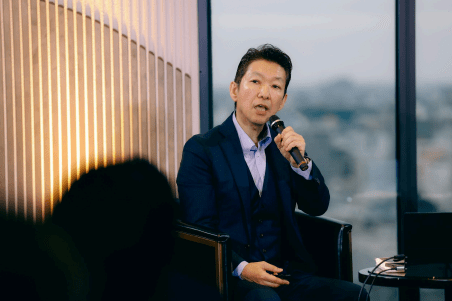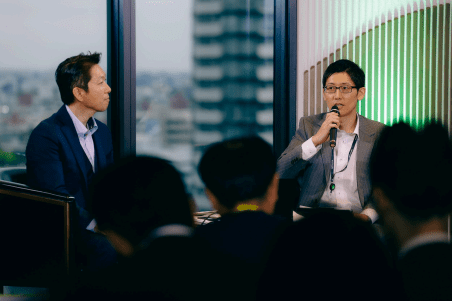
Hiromitsu Hatano, General Manager of ESG Promotion, ESG Center, Ricoh Company, Ltd.
Ricoh aims to achieve a sustainable society by focusing on environmental management. Since 1998, the company has committed to balancing sustainability with profitability, continually evolving its initiatives. As one of Japan’s leading environmentally-conscious companies, Ricoh integrates sustainability into its business strategy, turning it into measurable financial contributions.
This article is based on a discussion held on October 25, 2024, during EcoVadis World Tour Japan 2024. The conversation featured Ricoh’s Hiromitsu Hatano, General Manager of ESG Promotion, and Yuya Sato, Membership Account Manager at EcoVadis Japan. It explores Ricoh’s long-standing approach to advancing its sustainability strategy and delves into the novel concept of “future financial value.”
Sustainability Principles Rooted in the ‘Spirit of the Three Loves’
Could you tell us about the business and the principles behind your sustainability initiatives?
Hatano: Ricoh, founded in 1936, is primarily focused on hardware products like copiers and printers for office use. In recent years, we have been transitioning to digital services, placing significant emphasis on IT solutions and digital transformation (DX).
Our corporate principle, which has been integral since our founding, is the ‘spirit of the three loves.’ It stands for “love your neighbor, love your country, love your work.” These represent the idea of enriching people, local communities, and workplaces through our business.
This spirit resonates with the principles of the United Nations' Sustainable Development Goals (SDGs). As such, addressing social issues has been embedded in Ricoh’s DNA as a critical initiative. Internal surveys show that 98% of employees feel their work is connected to the SDGs. We believe our principles help guide individual actions across the company.
Balancing Environmental Protection and Profitability
Could you share the circumstances and challenges you faced when you began focusing on environmental management?
Hatano: In 1998, CEO introduced the idea of simultaneously achieving environmental protection and profitability. At the time, there was a widespread perception that these goals were at odds. Internally, many believed that dedicating a portion of profits to environmental conservation as a form of social contribution was sufficient.
To change this perception, we needed to create a system that linked environmental conservation to corporate growth. Our first step was improving yield rates at production sites to reduce defective products, which in turn minimized resource and energy waste. These efforts also led to improved profitability, demonstrating the significance of environmental management within the company.
To further accelerate company-wide efforts, we reformed our goal management system in 1999 by introducing a new framework. This framework expanded the traditional balanced scorecard to include environmental conservation as one of five evaluation criteria. As a result, awareness across departments increased, and we began receiving consultations from various divisions on how to advance environmental management. Working closely with these departments, we established key performance indicators (KPIs) and embedded sustainability into our operations.

How did you engage the leadership team and business units in advancing environmental management?
Hatano: For us, it was crucial to get the department heads involved. Simply incorporating sustainability criteria into departmental evaluations was not enough. Departments with a strong focus on financial performance, in particular, needed time to understand the importance of environmental initiatives.
To address this, we encouraged department heads to actively communicate about environmental management both internally and externally. For instance, we arranged opportunities for them to participate in related interviews and advertisements. These activities prompted them to think deeply about sustainability and gain the knowledge needed to articulate it in their own words.
Additionally, through our strategic goal management system, department heads and the CEO directly engaged in goal-setting and performance evaluations. Over time, this fostered a sense of ownership and responsibility.
When introducing renewable energy, we adopted the on-site power purchase agreement (PPA) model. By leasing factory rooftops to power providers for solar panel installation, we avoided upfront costs while accessing electricity at rates below market prices. This approach demonstrated how environmental conservation could directly lead to cost reductions and profitability, deepening understanding across departments.
From Non-Financial Goals to “Future Financial” Objectives
Ricoh refers to its ESG goals as “future financial” goals. What is the background behind this terminology?
Hatano: At Ricoh, we aim to contribute to a sustainable society while achieving continuous growth. Around 2020, we began using the term “future financial goals” instead of “non-financial goals” to describe our ESG initiatives. This change was driven by concerns that the term “non-financial” might lead to these activities being undervalued as unrelated to financial outcomes.
“Future financial” refers to initiatives that, while not immediately profitable, are expected to positively impact finances in three to ten years. For example, our initiative to recycle and resell used copiers initially faced concerns around profitability. However, by improving collection quality and advancing recycling design, we eventually made the business profitable over a ten-year period. This long-term perspective is what we call “future financial.”
How are these future financial initiatives implemented within Ricoh?
Hatano: In our 2023–2025 mid-term management strategy, we identified seven material issues under the categories of resolving social issues through business and robust management infrastructure. These include 16 company-wide ESG goals, referred to as future financial goals, each with specific KPIs.
These company-wide goals are broken down into departmental ESG goals. Each department incorporates these goals into its business plans and takes ownership of their implementation. To ensure accountability, goal achievement is linked to executive compensation, ensuring that management leads by example.
Using the EcoVadis Assessment as a Metric for Business Growth
Ricoh has been undergoing the EcoVadis assessment since 2009. What prompted this decision, and how do you utilize the assessment?
Hatano: We began undergoing the EcoVadis assessment at the request of our European clients. At the time, sustainability was particularly valued in European markets. Initially, around ten clients annually requested disclosure of our scores. By last year, this number had grown to 84, primarily from Europe.
The EcoVadis assessment has become key for building trust in sustainability-conscious markets. Since earning the Gold Medal in 2014, we have consistently worked toward achieving the Platinum Medal.
We also use EcoVadis as a “corporate health check”. By analyzing the assessment results, we identify areas for improvement and align our strategies with societal expectations. This approach has not only improved our operations but also strengthened our competitive edge.
Identifying Risks and Opportunities for 2040
How does Ricoh view environmental risks and turn them into business opportunities?
Hatano: Currently, we use frameworks such as the Task Force on Climate-related Financial Disclosures (TCFD) and the Taskforce on Nature-related Financial Disclosures (TNFD) to identify risks and opportunities and disclose their financial impacts. These frameworks help us analyze how environmental risks, such as climate change, resource circulation, and biodiversity, affect our business. For example, we have observed that changes in consumer behavior, such as the rise of remote work and efforts to reduce resource waste, have accelerated the trend toward paperless operations, which has had a significant impact on our business.
We view this risk as an opportunity and have accelerated our transition to digital services. By focusing on supporting small and medium enterprises with DX initiatives, we have reduced environmental impact while achieving revenue of approximately ¥170 billion (approximately €1.0625 billion). Looking ahead, we aim to further expand in the digital sector.
Additionally, we are not only addressing environmental concerns but also establishing businesses specifically designed to solve societal challenges. By setting revenue targets and disclosing results for these initiatives, we aim to create a model that advances ESG efforts alongside business growth.

Finally, what are Ricoh’s key priorities for advancing ESG practices?
Hatano: We focus on four priorities. The first is integrating ESG practices into management strategies and placing them at the core of our operations. We believe it is crucial to establish a consistent framework that covers decision-making, goal setting, performance disclosure, and linking ESG outcomes to our compensation system. This ensures that ESG practices function as a central element of management.
The second is connecting ESG initiatives with business growth. Rather than treating ESG as mere social contribution, we aim to position it as a driver of business strategy and development, ultimately achieving sustainable growth.
The third is proactively disclosing the results of our initiatives and incorporating feedback from stakeholders. This allows us to refine and enhance our efforts. Additionally, it is essential to create an environment where each employee can be proactive. By developing systems that link ESG initiatives to employee fulfillment and motivation, we encourage active participation and engagement from our workforce.
The fourth is building a company culture that shares and promotes a commitment to sustainability for the planet, society, and economy. While challenges remain, we aim to build on this foundation and continue advancing our initiatives further.
About the Author
Follow on Twitter Follow on Linkedin Visit Website More Content by EcoVadis EN























